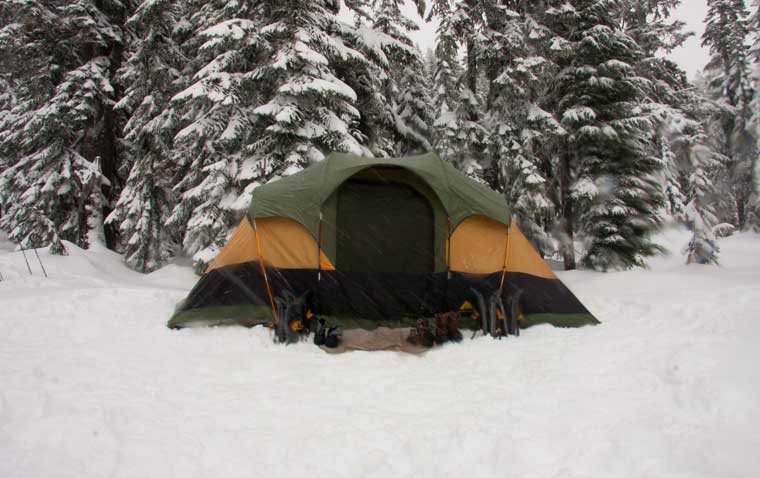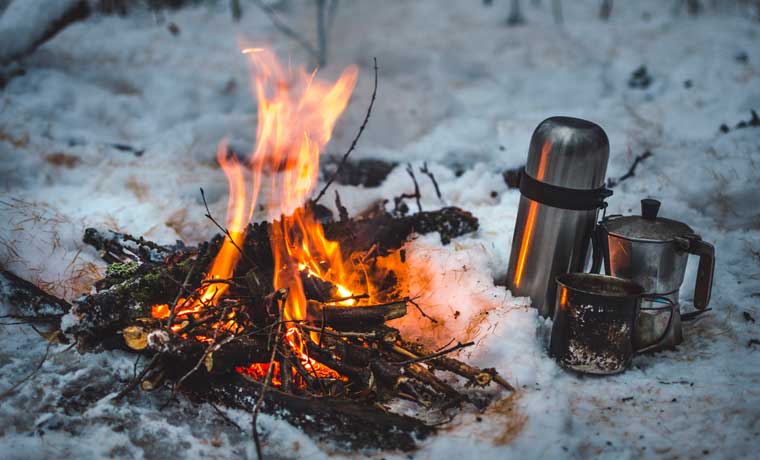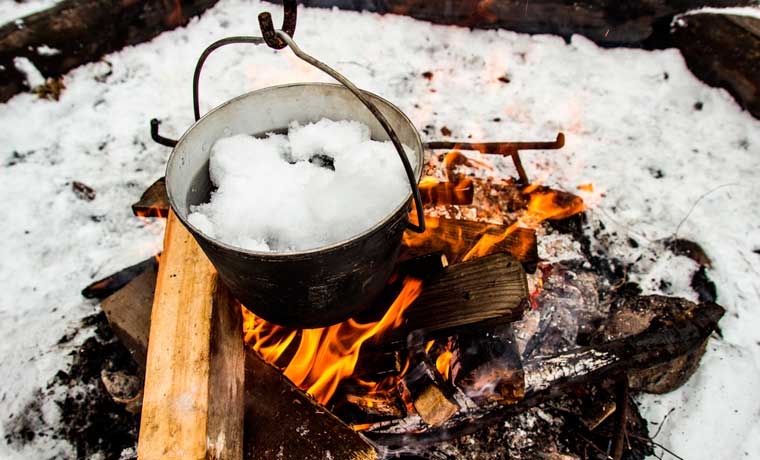Much like hiking during the winter months, winter camping can be a highly satisfying and enjoyable way to spend time in the wilderness. Aside from the beauty of frosty white scenery and untouched landscapes, you usually get to enjoy the fresh, invigorating winter air all to yourself.
But when daylight hours are limited and the weather is more often than not throwing freezing wind and sideways snow in your face, it can be all too easy to make excuses for not getting out there. If you’re not prepared, or don’t know what you’re doing, winter camping can easily turn into an exercise of survival rather than enjoyment. So check out our winter camping tips to get you ready to embrace the frozen forests of your own wilderness winter wonderland.
Dress right for winter camping
Staying warm may seem like a simple task, but it’s not just all about wearing the right clothing. There are also some surprising and easy ways in which you can avoid getting cold that you may not have thought of. Read our tips on how to stay warm when camping to minimise the chance of feeling like you’ll never warm up again. When it comes to clothing, there are a few key things to remember:
1Wear layers
It may seem like overkill, but wearing multiple layers of extreme cold weather gear will keep you super cosy and enable you to adjust your temperature easily if you are moving around a lot.
2Avoid sweating too much
Although moving around is great to keep your body temperature up, if you exert yourself too much then excess sweat, once cooled, can increases the risk of hyperthermia. To help with this, wear merino base layers to wick away excess moisture from your skin, and make sure your jacket and pants have zippered vents that you can open up before you start to sweat.
3Wear eye protection
If you are in snowy conditions then wearing sunglasses or ski goggles is super important to minimise the risk of snow blindness. Even if there isn’t snow on the ground, it’s easy to forget eye protection in the winter when the sun is shining. So add them to your winter camping checklist.
4Stop the wind
The temperature on the thermometer counts for very little if the wind is blowing. And the harder it blows, the colder the wind chill factor. So make sure your outer layers are fully windproof with no gaps for the freezing breeze to creep in.

Use the right winter camping gear
Although some of your 3 season camping gear will be fine in cold conditions, some of it simply won’t function properly or won’t be warm enough. When it comes to the warmth of your sleeping gear, it will help to have a good idea of what sort of temperatures you are likely to be living in, and then you can work from there.
5Use a steep sided tent
Most 3 season tents will hold up fine in moderate winter conditions, but a good 4 season tent will be much stronger in high winds, and the steep sides of cold weather camping tents will deal with snow build up much better than a 3 season tent.
6Be warm from the ground up
A good sleeping bag just won’t be good enough if you can’t keep the cold out from below you. Your sleeping pad should have a high R-value of 5 or more, and if it’s super cold then placing a closed-cell foam pad underneath it will also help.
7Use a down sleeping bag
Down is the best insulator, so long as it stays dry. When checking the temperature rating of your winter sleeping bag, bear in mind that the ‘extreme rating’ is the lowest temperature at which an adult female will be kept alive. This is different to the ‘comfort rating’, and won’t necessarily protect against hypothermia and frostbite.
8Line your sleeping bag
Condensation within your sleeping bag can become a problem, especially if you sleep with your head inside your bag. Once the excess moisture from your body heat gets into your sleeping bag, there is a danger that it will freeze. To help prevent this, use a vapour barrier sleeping bag liner to prevent the moisture from reaching the insulation of your sleeping bag. Be sure to wear wicking layers to help minimise moisture build up on your body.
9Sit on your camping pillow
A well insulated camping pillow will help with comfort levels at night, but also makes sitting on the cold snow a much less cold and unpleasant experience. Be sure to put a ground sheet beneath it to stop the pillow from getting wet.
10Use lithium batteries
Extended time in the cold will decrease the lifespan of your batteries. And with so many hours of darkness, losing the light of your headlamp can be really inconvenient. Lithium batteries deal with low temperatures much better than alkaline batteries. But it’s always sensible to bring spares.

Cooking, eating and drinking when winter camping
Camp cooking can be a little different in freezing temperatures. Stoves and their fuel perform differently and you’ll need to increase your calorie intake. So make sure you have some great backpacking food at the ready.
11Eat lots
High calorie, high fat foods are essential for helping to keep you warm and for replacing the extra calories you will burn in the cold conditions. Eat regularly and go to bed with a full belly.
12Don’t worry about fresh food turning bad
You can enjoy fresh meat and cheese all day long if you like! The cold temperatures will keep perishable food fresh for as long as it would in your refrigerator at home.
13Bring a second stove
Even if you have the most reliable camping stove in the world, freezing temperatures can easily cause stoves to malfunction or perform poorly. Bring a backup, just in case.
14Choose the right fuel
Fuel will burn much more quickly in the cold, so account for that when packing. But you will also need to consider what type of fuel you bring. Liquid fuel (white gas) burns well at sub-zero temperatures, where canister gas will fail.
15Boil water to purify it
To ensure that the water you collect is safe to drink, you will need to boil it. Water filters often fail in cold conditions and chemical purification takes much longer to work in the cold.
16Bury your water
Once you’ve boiled your water or melted your snow, prevent it from freezing again by burying it in the snow. Or if it’s in constant use, then turn the bottle upside down as it will freeze from the top down.
17Don’t eat snow
It takes a whole load of energy to turn freezing snow into liquid that will adequately hydrate you. So use that energy to collect and melt the snow instead.
Personal hygiene when winter camping
Camping hygiene can become a little more tricky in the cold. Wear merino socks and thermals to help reduce body odours, and adopt the mighty baby wipe! But your toilet facilities are the most problematic.
18Pee in a bottle / use an FUD
If you actually manage to get warm at night, then the last thing you want to do is get out of your tent to pee. Have a VERY well labelled bottle at the ready for when nature calls at night. For the ladies, an FUD (female urinary device) will make this possible.
19Dig a cathole in the snow
Make sure it is away from water, not on a slope and away from the trail. Water contamination may not seem like an issue when the ground is covered in snow, but consider what will be left as soon as it melts! For more information on this take our Leave Not Trace Principles Quiz.
20Bag your TP
Again, burying your toilet paper in the snow may seem like you’ve solved the problem, but the snow will melt at some point, so bag your paper. Or wrap it up in clean paper and burn it if you have a fire.
21Wear sunscreen
In theory, there will be very little skin exposed to the elements, however that doesn’t mean the sun won’t burn your nose and cheeks if they’re not protected. You won’t need loads so pack a small tube to share with your group.
22Cover exposed skin with vaseline
It’s not just the sun that will attack your skin. The cold and wind will do everything it can to cause damage to any exposed skin, so cover it with a thin layer of vaseline for some extra protection.

Around the campsite
Setting up a good campsite not only makes your time out in the cold much more comfortable, but it also gives you things to do that mean you’re not just sitting around getting cold.
23Get a fire going
If at all possible, get a good fire going. Not only will it provide warmth, but it will boost morale like nothing else, and keeping it going will provide a good focus for the day. You can also save on stove fuel by melting snow on it for drinking.
24Pack down the snow before pitching the tent
Doing this ensures that there are no thin spots of snow that will melt with your body heat, creating holes and dips that will be uncomfortable to sleep on.
25Dig a pit under the tent vestibule
This will provide a good space for you to sit and take your boots and outdoor gear off before you get into your tent. It also provides a good spot to store gear that you don’t want in your tent.
26Vent your tent
No matter how cold it is, it is essential that you open up a couple of vents in your tent. This will hugely help reduce condensation build up that can then freeze on the inside of your tent.
27Sleep with your boots
If you have boot liners, then take them out of the boots and put them at the bottom of your sleeping bag. If you just have regular hiking boots then put them in a waterproof bag and do the same.
28Keep your batteries and devices warm
If you have a little pocket inside your sleeping bag, then put them in there overnight, and store them in your breast jacket pocket during the day. Keeping batteries and devices warm will help extend their lifespan.
29Dig out a camp kitchen
If you intend on spending a few days in one place then create a more comfortable space to cook in by digging trenches and seats in the snow.
The key to enjoying winter camping comfortably is to stay warm, whatever you are doing. So if you only implement one of these tips on your next (or first) winter camping trip, then whatever you do, stay warm!



